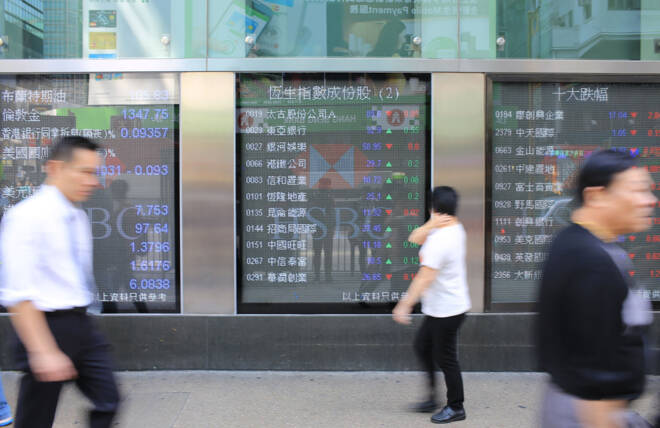Advertisement
Advertisement
Hang Seng Index Falls on Baidu Slumps; ASX 200 and Nikkei Advance
By:
Key Points:
- Hang Seng Dips Amid Earnings Weakness: Baidu plunges 8.23% as stimulus uncertainty weighs on Chinese markets.
- ASX 200 Surges Despite PMI Contraction: Broad sector gains lift ASX as investors bet on a 2025 RBA rate cut.
- Nikkei Rises on Wall Street Momentum: Tech stocks lead gains; stronger yen and BoJ rate hike bets weigh on exporters.
US Markets: Wall Street Amid Economic Optimism
On Thursday, November 21, US equity markets gained momentum following mixed sessions earlier in the week. The Nasdaq Composite Index edged 0.03% higher, while the Dow and the S&P 500 saw gains of 1.06% and 0.53%, respectively.
News of the US Justice Department wanting Google to sell Chrome left the Nasdaq with modest gains. Alphabet Inc. (GOOGL) slid by 4.74% on Thursday. Meanwhile, Nvidia (NVDA) advanced by 0.53% as solid earnings countered concerns about potential supply constraints extending to 2026.
US Labor Market Strengthens, Fed Speculation Builds
On Thursday, US initial jobless claims boosted demand for riskier assets. Initial jobless claims dropped from 219k (week ending November 9) to 213k (week ending November 16). Lower claims signaled a resilient US labor market, supporting private consumption, which accounts for over 60% of the US GDP.
The weekly data had a modest impact on sentiment toward the Fed rate path. According to the CME FedWatch Tool, the chances of a 25-bps December Fed rate cut rose from 55.7% on November 20 to 59.6% on November 21.
Geopolitical Risks Persist: Ukraine War and Nuclear Concerns
Investors should continue monitoring Ukraine war-related news updates. An escalation in the war has raised the threat of a Russian response with nuclear weapons. More Russian nuclear threats could fuel a flight to safety.
Japan’s Services PMI and Inflation Data Boost BoJ Rate Hike Bets
On Friday, November 22, Japan’s inflation and Services PMI fueled bets on a near-term Bank of Japan rate hike.
Japan’s annual inflation rate eased from 2.5% in September to 2.3% in October, holding above the BoJ’s 2% target. Holding above the 2% target is crucial for the BoJ to raise interest rates.
The all-important Jibun Bank Services PMI increased from 49.7 in October to 50.2 in November, signaling a return to expansion. According to the Flash Survey, prices charged for services accelerated sharply in November, a key consideration for the BoJ.
Bank of Japan Governor Kazuo Ueda had previously emphasized the importance of services sector price trends, stating,
“October is a month when service price revisions are concentrated in Japan, so we must scrutinize data carefully.”
Notably, the USD/JPY dipped below 154 on Friday morning before steadying at 154.434.
Hang Seng Index Extends Its Losses from Thursday
In Asian markets, the Hang Seng Index was down 0.33% on Friday morning. Corporate earnings and lingering concerns over US tariffs on China weighed on the Index.
The Hang Seng Mainland Property Index (HSMPI) declined by 0.86%, while the Hang Seng Tech Index gained 0.03%. Baidu (9888) tumbled 8.23% on poor Q3 earnings, with Alibaba (9988) dropping by 1.90%. Conversely, Sunny Optical Technology Group (2382) rallied 5.80%, with BYD Electronic International (0285) advancing by 5.79%.
Mainland China’s equity markets also moved lower. The CSI 300 and the Shanghai Composite saw declines of 0.53% and 0.53%, respectively.
Nikkei Index Tracks Wall Street Higher
Japan’s Nikkei Index advanced by 1.02% on Friday morning, tracking Wall Street’s overnight gains.
Tech stocks Softbank Group Corp. (9984) and Tokyo Electron (8035) were up by 0.69% and 2.55%, respectively. However, Nissan Motor Corp. (7201) declined by 0.56% on a potential BoJ rate hike and stronger Japanese Yen prospects.
ASX 200 Rallies on Broad-based Sector Gains
In Australia, the ASX 200 Index rallied 0.94% on Friday morning. Australia’s Judo Bank Services PMI unexpectedly fell from 51.0 in October to 49.6 in November, fueling bets on a Q1 2025 RBA rate cut.
Banking, gold, mining, and oil stocks contributed to the morning gains.
Commonwealth Bank of Australia (CBA) advanced by 1.08%, while mining giants BHP Group Ltd. (BHP) and Rio Tinto Ltd. (RIO) saw gains of 0.79% and 1.40%, respectively. Iron ore spot prices rose on Thursday, boosting demand for mining stocks.
Gold-related stock Northern Star Resources Ltd. (NST) and Woodside Energy Group Ltd. (WDS) also advanced following overnight gains in gold and oil prices.
Outlook
Investors should monitor central bank commentary and developments in the Ukraine conflict. Potential stimulus measures from Beijing also need consideration. Stimulus measures targeting domestic consumption could offset concerns about US tariffs, potentially fueling demand for riskier assets.
About the Author
Bob Masonauthor
With over 28 years of experience in the financial industry, Bob has worked with various global rating agencies and multinational banks. Currently he is covering currencies, commodities, alternative asset classes and global equities, focusing mostly on European and Asian markets.
Did you find this article useful?
Latest news and analysis
Advertisement
